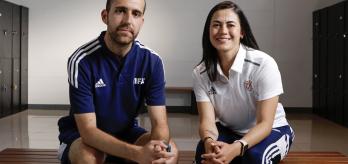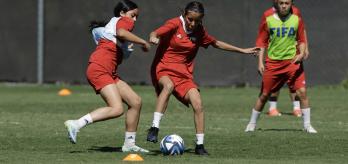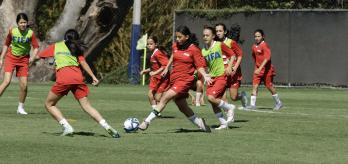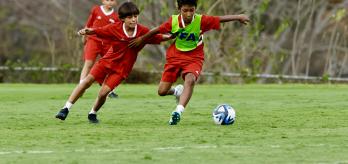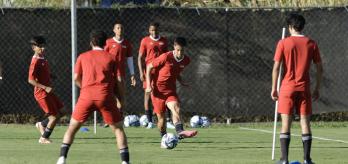In such a scenario, an attacking team should use a range of passing combinations and on- and off-the-ball movement. This session focuses on a series of pass-and-move sequences and build-up patterns that are designed to help a team progress through the opposition’s lines and defensive structure.
In the session, Costa Rican Football Association Talent Coach Lina Arana and FIFA Talent Coach Claudio García deliver a series of passing exercises to a group of U-14 girls in Costa Rica. The session primarily focuses on building and progressing through different game situations and phases. Players work mainly in units during various exercises to gain a better understanding of different movements and patterns. The session concludes with a team game where players are asked to incorporate all the principles practiced in the previous exercises into a real-game scenario.
Session overview
Key coaching points
-
Playing firm, short and accurate passes helps players to progress the ball efficiently and quickly.
-
Adopting a side-on, open body position and being ready to receive the ball on the half-turn helps attacking players to evade pressing players or to play in a direction that enables them to progress play.
-
Out-of-possession players should provide width and depth to create space for team-mates and cause uncertainty amongst defenders.
-
When possible, players should play quick one-twos and perform quick interchanges using a third player to draw defenders out of position and advance into advantageous positions.
-
Players should create overloads in wide areas to progress play quickly and should switch play quickly when a channel is closed off.
Part 1: passing circuit
The first exercise is a passing circuit that serves as a technical and physical activation. The circuit works on an unit scale and simulates a scenario that involves centre-backs or central midfielders, full-backs and wingers performing various combinations to practise and test their passing accuracy.
Set up 2 identical circuits as follows:
-
Mark out a 30m x 20m exercise area.
-
Place 3 mannequins an equal distance apart across the middle of the exercise area.
-
Position a cone 10m either side of the central mannequin.
-
Set a cone 5m from and either side of each outer mannequin in a slightly offset position.
-
Position a mini-goal at either end and on opposite sides of the exercise area.
-
Divide the group in 2 and assign each player to a passing circuit.
-
Place a player at each cone with 2 players at station A.
-
A passes to B.
-
B takes a touch before passing to C.
-
C performs a directional control and passes the ball into the mini-goal on their side of the exercise area.
-
Every player follows their pass and rotates to the next position in the sequence.
-
After finishing into the mini-goal, C collects the ball and rotates to become A on the opposite side of the circuit.
-
The circuit is initially performed in an anticlockwise direction and switches to a clockwise direction after the sequence has been completed several times.
-
A begins the sequence by taking a touch, which prompts C to drift into the space between the outer and central mannequins.
-
A passes to C.
-
As the ball travels towards C, B runs forwards to occupy the space vacated by C.
-
C plays a first-time pass to B, who takes a touch before finishing into the mini-goal.
-
Players are encouraged to perform each action in no more than 2 touches.
-
Rotations: C becomes B. A becomes C.
-
A passes to B.
-
B passes to C before drifting into the space between the outer and central mannequins.
-
C receives B’s pass and plays the ball into B’s path.
-
B passes the ball into the mini-goal.
-
Rotations: C becomes B. A becomes C.
-
Players should play firm, accurate passes to enhance the fluidity of the circuit.
-
Players should play passes either into their team-mate’s feet or their path, depending on whether they are moving towards the ball or running forwards.
-
Players should perform a directional control by receiving the ball on the half-turn or adopting a side-on body position to enable them to move in the direction in which they intend to play.
-
Players should time their movement and passes so that the recipient of the pass meets the ball when it reaches them, thereby avoiding checking their run or taking any extra touches.
Part 2: 3v3 plus 2 possession game
This possession game works on unit-level aspects and puts the previous passing sequences into practice. The sequences used help players evade pressure all over the pitch to progress the ball using passing combinations and intelligent movement.
-
Mark out two 25m x 15m exercise areas.
-
Divide each exercise area in half.
-
Split the players into 2 groups of 8 and assign each group to an exercise area.
-
Set up a 3v3 (oranges v. blues) in each exercise area and position a neutral player on either side of the exercise area.
-
The 2 teams compete to keep possession and connect with the player at each end of the exercise area.
-
The in-possession team can use the 2 neutral outside players to progress play into the other half.
-
Once the ball is played into the other half, a player from each team must transfer into the half along with the 2 neutral outside players.
-
The blues’ objective is to connect with the blue end players.
-
The oranges try to prevent the blues from connecting with the blue end players.
-
The blue end players must remain close to the end zones at all times in readiness to receive a pass.
-
If the oranges win the ball, the teams swap roles, with the 2 blue end players vacating the end zones to go and press.
-
When the ball goes out of play, the coach feeds a new ball into the first player to call for it.
-
The neutral outside players can pass the ball to each other and to the end players.
-
Players must react to their team winning or losing possession by taking up positions that allow them to either retrieve or retain the ball.
-
The neutral outside players should offer the ball carrier clear passing lanes and adopt a side-on body position to allow them to see both of the end players and the central player while keeping passing lanes open.
-
The in-possession team should try to open the pitch up and combine by playing triangle passing sequences.
-
The out-of-possession team should try to position themselves in a line in a central area and shut off 2 possible passing options.
-
Ball carriers should use feints, shimmies and disguised passes to evade pressing players and find passing options further forwards.
Part 3: 4v4 and 4v4 plus Goalkeepers
These small-sided games focus on the unit scale and work on creating passing lanes and sequences so the ball can be progressed, and chances can be created. The unit must provide lots of movement off the ball and support play.
-
Mark out two 25m x 20m exercise areas.
-
Place 2 mini-goals at either end of each exercise area.
-
Mark out a 3-metre area running from the mini-goals. Place a goalkeeper inside the area at each end of exercise area A.
-
Divide the group into 4 teams of 4, and assign 2 teams to each area.
-
Set up a 4v4 inside both exercise areas.
-
The exercise begins with either team in possession.
-
The in-possession team try to progress play and score into either mini-goal at the opposite end.
-
The out-of-possession team try to win the ball and score.
-
If the ball goes out of play, the coach feeds a new ball to the in-possession team, restarting play from a goalkeeper in exercise area A.
-
Players cannot score from inside the 3-metre area, which also marks the goalkeeper’s area of play in exercise area A.
-
Players should provide width and depth to open up the pitch and create passing lanes.
-
If a player drops to receive the ball, their team-mates should identify the areas in which space could appear.
-
The in-possession team should use the goalkeeper in the build-up phase to open up more passing lanes and improve their chances of progressing play.
-
The pressing team should close spaces in central areas to give them a greater chance of winning the ball and preventing the opposition from progressing play.
-
When possible, players should play disguised passes, which can serve to draw opponents out of position.
Part 4: 8v8 plus 2 game
This game focuses on a team scale and puts all the previously covered aspects into a real-game scenario. The game has been designed to focus on the build-up from the goalkeeper and use the width to create chances.
-
Mark out a 60m x 50m exercise area.
-
Place a full-size goal and a goalkeeper at each end of the exercise area.
-
Mark out a wide channel on each side of the exercise area.
-
Set up a 8v8 scenario, with 2 neutral wide players creating a 10v8 situation in favour of the in-possession team.
-
Organise the oranges in a 3-2-2 formation.
-
Set the blues up in a 4-2-1 system.
-
The exercise starts with the oranges’ goalkeeper in possession.
-
The oranges’ objective is to build up play to try to score.
-
The blues’ objective is to win the ball. If they manage to do so, the teams swap roles.
-
The blues can only initiate their press once the goalkeeper has played the ball to an orange centre-back.
-
The neutral wide players support the in-possession team.
-
Given that the focus is on building up from the back, play always restarts with the goalkeeper.
-
Players should focus on constructing passing patterns and performing off-the-ball movement within the assigned team formations.
-
Using the neutral wide players allows the in-possession team to create a numerical advantage on one side of the exercise area.
-
In-possession players should look to play forwards and provide support runs to ensure that their team-mates have a passing option at all times.





